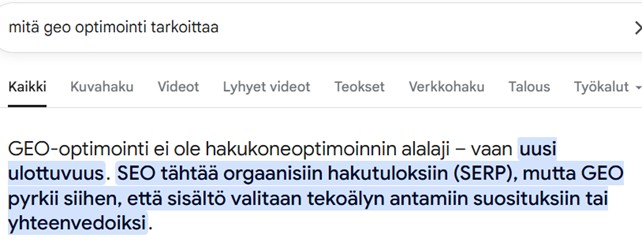
What is AI optimisation or GEO and how is it done?
AI optimisation is worth taking over, as some searches have and will move from search engines to AI services.
Search engine optimisation is not going away, but GEO has risen alongside it and in many ways they go hand in hand. Well-done SEO is an excellent starting point for AI optimisation
What is GEO?
GEO or Generative Engine Optimization is an acronym for a new way to optimise content for AI-driven search engines.
Unlike traditional SEO, GEO focuses not just on how well content shows up in Google searches, but on how a company's name or content shows up in AI-assisted search results, such as.
- In Bing's Copilot
- ChatGPT.
- In Google search results summaries (example below)

The AI does not provide a list of links, but an AI-generated response or suggestion. And this is where GEO comes in: how do you ensure that your company or content is mentioned in these responses?
The importance of AI optimisation
The goal of AI optimisation is exactly the same as search engine optimisation. When your business is found in the right circles, your brand awareness increases and you get sales through contacts.
We received a request for a quote for digital marketing, where the client had found us using AI. They had told the AI their needs and then asked for a list of companies that might be a good fit for them, and the AI recommended they contact Digiteam.
How is AI optimisation done in practice?
AI optimisation relies on much the same things as traditional search engine optimisation. If your traditional search engine optimisation is in order, your business may already be found in AI in a variety of contexts.
However, there are specific aspects of AI optimisation that should be taken into account. The most important of these are content structures and so-called trust signals.
AI looks for trust signals, reviews and recommendations
When generating answers and suggestions, the AI scours the web for recommendations and lists of what it considers to be official sources. References, links, directories, various business listings, mentions on social media platforms and in industry publications, and reviews will make a company stand out to the AI.
The more mentions, the more likely the company name or its content will appear in AI responses.
How should content be developed for AI optimisation?
When content is structured according to SEO guidelines, it should have clear headings and header hierarchies. Content can be classified in code using structured data (Schema Markup), which helps the AI understand what kind of content is being written where. This classification is therefore not visible to the site user.
In addition, the content should take into account the following issues:
1. Asking questions to get information from AI
Content that directly answers questions is more likely to be seen.
- Format your content in Q&A format
- Clearly titled
- Avoid unnecessary detours
Example: do not write "There are many ways for companies to approach AI optimisation..." but rather "How is AI optimisation done?"
2. The content should be a source that AI can refer to
The content should be concise, informative and of such a nature that it can be highlighted as a stand-alone entity while retaining its core message.
AI looks for credible and knowledgeable sources. Build your website around trusted sources of information that:
- Provide accurate and timely information
- Use professional but understandable language
- Based on a clear structure and headings
Blog posts, tutorials and good service descriptions have a great potential for generative responses.
Where to start with GEO optimisation?
GEO optimisation should be done in stages. It is a long-term continuous improvement process that needs to take into account the ongoing evolution of AI.
The key to designing AI optimisation is to put yourself in the customer's shoes and think about what questions they are looking for solutions to and how to answer them exhaustively.
GEO measures
- Find out the current state of search engine optimisation on your website and get the basics right
- Map and list existing content, and how to better tailor it for AI optimisation in a question-and-answer format
- Write testimonials, collect recommendations and reviews
- Make sure you're found in directories and check your description in Google Business Profile
- Create articles, guides, studies and data publications
- Collect links from other websites and mentions in social media channels


